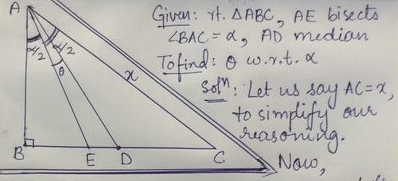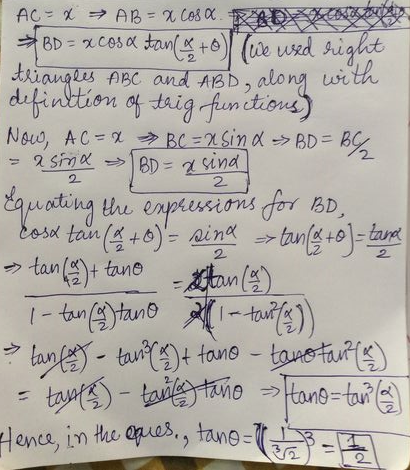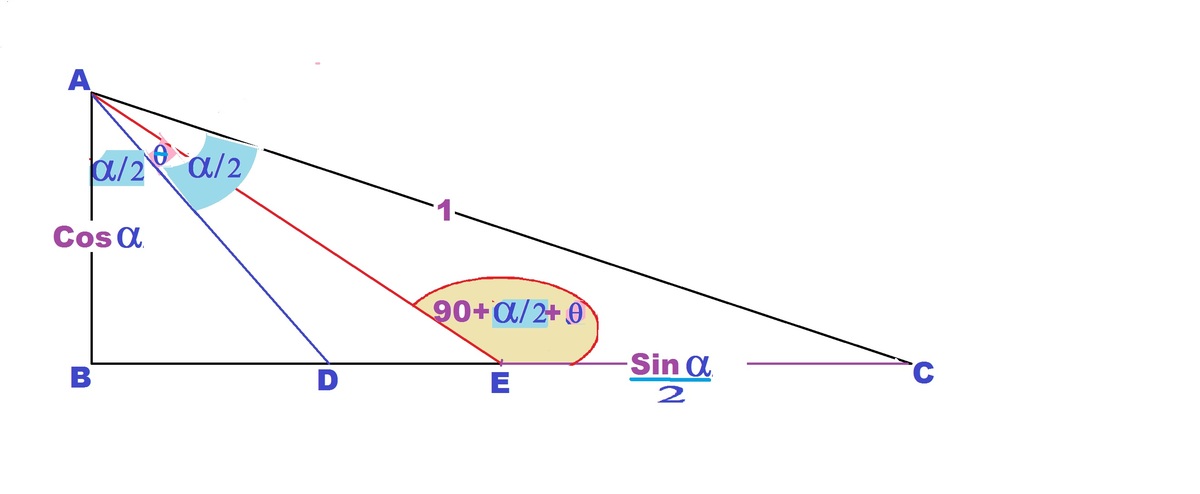Medians And Bisectors
In a right triangle, find the measure of angle θ between the median and the angle bisector drawn from the vertex of the acute angle equal to α .
Now, if tan ( 2 α ) = 3 2 1 , enter tan ( θ ) as your answer.
The answer is 0.5.
This section requires Javascript.
You are seeing this because something didn't load right. We suggest you, (a) try
refreshing the page, (b) enabling javascript if it is disabled on your browser and,
finally, (c)
loading the
non-javascript version of this page
. We're sorry about the hassle.
3 solutions
Moderator note:
Good explanation.
In such cases where the diagram may be misleading because we're making assumptions about the location of points, it is best to justify why D appears to the left of E.
Impressive. I used calculator given trig ratios to get the correct answer. Your method is much more satisfying.


Note that here, we first found the answer for a more general problem, i.e. to express θ with respect to α , and then after finding the trig relation, plugged in the value of t a n ( 2 α ) .
Moderator note:
In such cases where the diagram may be misleading because we're making assumptions about the location of points, it is best to justify why D appears to the right of E.
Using directed angles will also ensure that you get the correct signage, for values where D would have appeared to the left of E.
Similar approach but using coordinates make it simpler!!
Nice Approach! . I Did it using m-n theorem(applying m-n theorem will you a trigonometric equation consisting of alpha and theta) just you need to solve that out (although it would be a bit calculative but my writing is similar to yours (but dirtier) and i was able to solve in half page. :)
A very bad explanation of the task producing confusion!!! A drawing would have been wise to avoid misunderstandings!
Log in to reply
I didn't find much time to type up the whole of the solution as well as attaching computer generated graphics due to exams. But I do think the solution is clear, try to understand.
Log in to reply
The problem for me was the o r i g i n a l presentation of the task itself (not your solution). My misunderstanding then led to another way of solution!
Log in to reply
@Andreas Wendler – In future, if you spot any errors with a problem, you can “report” it by selecting "report problem" in the menu. This will notify the problem creator who can fix the issues.
I did attach a hand-written drawing. If that's not what you want, I am helpless. I will try to enhance the solution once my exams are over.
Given diagram wasted my time.
Log in to reply
Oh, I just saw now. Some other moderator added the diagram. I will replace it with a proper one soon.

Without the loss of generality we can assume A C = 1 . ∴ A B = C o s α , B C = S i n α . Applying Sin Law to Δ A E C S i n ( 9 0 + θ + 2 α ) A C = S i n ( 2 α − θ ) E C ⟹ C o s ( 2 α + θ ) 1 = S i n ( 2 α − θ ) 2 S i n α ⟹ 1 − T a n 2 α ∗ T a n θ = S i n α 2 ∗ T a n 2 α − S i n α 2 ∗ T a n θ . ⟹ T a n θ = T a n 2 α − S i n α 2 1 − S i n α 2 ∗ T a n 2 α S i n α 1 = T a n 2 α + T a n α 1 = T a n 2 α + 2 ∗ T a n 2 α 1 − ( T a n 2 α ) 2 = 2 1 ∗ T a n 2 α − 2 ∗ T a n 2 α 1 . ∴ T a n θ = T a n 2 α 1 ( T a n 2 α ) 2 = ( T a n 2 α ) 3 = 2 1
Let the right-angle triangle be △ A B C with ∠ B A C = α , ∠ A B C = 9 0 ∘ , ∠ D A B = ∠ D A C = 2 α and B E = E C , therefore, LaTeX: ∠ D A E = θ .
Let A B = 1 , then
B C = tan α = 1 − tan 2 2 α 2 tan 2 α = 1 − ( 3 2 1 ) 2 3 2 2 = 2 3 2 − 1 2 3 4
⇒ B E = 2 B C = 2 3 2 − 1 2 3 1 ≈ 2 . 1 4 4 9 and B D = tan 2 α = 2 − 3 1 = 0 . 7 9 3 7 . Since B E > B D , we have B E = tan ( 2 α + θ ) . Therefore,
tan ( 2 α + θ ) ⇒ 1 − tan 2 α tan θ tan 2 α + tan θ 1 − 2 − 3 1 tan θ 2 − 3 1 + tan θ 2 3 1 + 2 3 2 tan θ − 2 − 3 1 − tan θ 2 3 2 tan θ tan θ = 2 3 2 − 1 2 3 1 = 2 3 2 − 1 2 3 1 = 2 3 2 − 1 2 3 1 = 2 3 1 − tan θ = 2 − 3 1 = 2 1 = 0 . 5